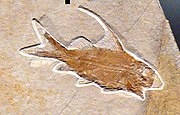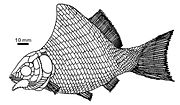
Actinopterygii, members of which are known as ray-finned fish or actinopterygians, is a class of bony fish that comprise over 50% of living vertebrate species. They are so called because of their lightly built fins made of webbings of skin supported by radially extended thin bony spines called lepidotrichia, as opposed to the bulkier, fleshy lobed fins of the sister class Sarcopterygii. Resembling folding fans, the actinopterygian fins can easily change shape and wetted area, providing superior thrust-to-weight ratios per movement compared to sarcopterygian and chondrichthyian fins. The fin rays attach directly to the proximal or basal skeletal elements, the radials, which represent the articulation between these fins and the internal skeleton.

The Amiiformes order of fish has only two extant species, the bowfins: Amia calva and Amia ocellicauda, the latter recognized as a separate species in 2022. These Amiiformes are found in the freshwater systems of North America, in the United States and parts of southern Canada. They live in freshwater streams, rivers, and swamps. The order first appeared in the Triassic, and the extinct members include both marine and freshwater species, many of which are morphologically disparate from bowfins, such as the caturids.

Semionotiformes is an order of ray-finned fish known from the Middle Triassic (Anisian) to the Late Cretaceous (Maastrichtian). Their closest living relatives are gars (Lepisosteidae), with both groups belonging to the clade Ginglymodi within the Holostei. The group includes both freshwater (Semionotidae) and marine adapted forms. Many members of the family Macrosemiidae, had elongated dorsal fins, often associated with an adjacent area of skin which was free of scales. These fins were likely undulated for use in precision swimming. The body morphology of macrosemiids suggests that they were slow swimmers that were capable of maneuvering around complex topography, such as reef environments.
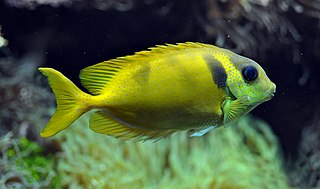
Neopterygii is a subclass of ray-finned fish (Actinopterygii). Neopterygii includes the Holostei and the Teleostei, of which the latter comprise the vast majority of extant fishes, and over half of all living vertebrate species. While living holosteans include only freshwater taxa, teleosts are diverse in both freshwater and marine environments. Many new species of teleosts are scientifically described each year.
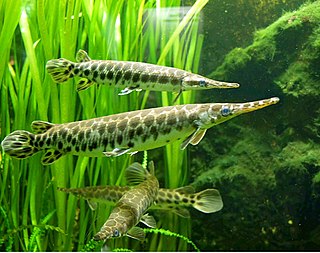
Lepisosteiformes is an order of ray-finned fish and the only living members of the clade Ginglymodi. Its only extant representatives are the gar, and it is defined as all members of Ginglymodi that are more closely related to gar than to the extinct Semionotiformes, the other major grouping of ginglymodians. They are one of two extant orders in the infraclass Holostei alongside the Amiiformes.
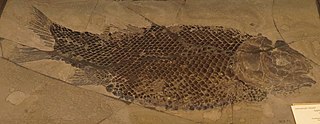
Lepidotes is an extinct genus of Mesozoic ray-finned fish. It has long been considered a wastebasket taxon, characterised by "general features, such as thick rhomboid scales and, for most of the species, by semi-tritorial or strongly tritorial dentition". with dozens of species assigned to it. Fossils attributed to Lepidotes have been found in Jurassic and Cretaceous rocks worldwide. It has been argued that Lepidotes should be restricted to species closely related to the type species L. gigas, which are only known from the Early Jurassic of Western and Central Europe, with most other species being not closely related, with other species transferred to new genera such as Scheenstia.Lepidotes belongs to Ginglymodi, a clade of fish whose only living representatives are the gars (Lepisosteidae). The type species L. gigas and close relatives are thought to be members of the family Lepidotidae, part of the order Lepisosteiformes within Ginglymodi, with other species occupying various other positions within Ginglymodi.

Holostei is a group of ray-finned bony fish. It is divided into two major clades, the Halecomorphi, represented by the single living genus, Amia with two species, the bowfins, as well as the Ginglymodi, the sole living representatives being the gars (Lepisosteidae), represented by seven living species in two genera. The earliest members of the clade, which are putative "semionotiforms" such as Acentrophorus and Archaeolepidotus, are known from the Middle to Late Permian and are among the earliest known neopterygians.
Ferganoceratodus is a genus of prehistoric lungfish known from the Mesozoic of Asia. Based on morphological evidence, it has either been recovered as a basal member of the Ceratodontiformes or to be the sister group of the Neoceratodontidae.

Halecostomi is the name of a group of neopterygian fish uniting the halecomorphs and the teleosts, the largest group of extant ray-finned fish.

The Early Cretaceous Phu Kradung Formation is the lowest member of the Mesozoic Khorat Group which outcrops on the Khorat Plateau in Isan, Thailand. This geological formation consists of micaceous, brown to reddish-brown siltstone beds with minor brown and grey shale and sandstone beds. Occasional lime-noduled conglomerate occurs.
The Khok Kruat Formation is a rock formation found in northeastern Thailand. It is the uppermost formation of the Khorat Group. It is dated to the Aptian stage of the Early Cretaceous period, and is notable for its fossils of dinosaurs. It is equivalent to the Gres superieurs Formation of Laos. The group is a fluvial formation consisting primarily of red siltstones and sandstones.
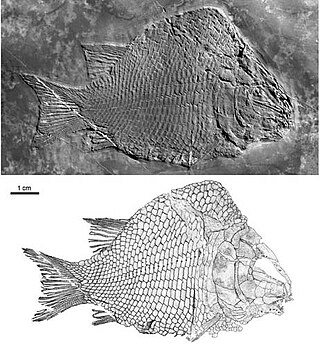
Kyphosichthys is an extinct genus of basal actinopterygian bony fish known from the lower Middle Triassic (Anisian) marine deposits in Luoping, eastern Yunnan Province, southwestern China. The species is the first known fossil record of highly deep-bodied ginglymodians.

Scheenstia is an extinct genus of neopterygian ray-finned fish from the Late Jurassic–Early Cretaceous of Europe. Fossils have been found in both marine and freshwater environments.

Halecomorphi is a taxon of ray-finned bony fish in the clade Neopterygii. The only extant Halecomorph species are the bowfin and eyespot bowfin, but the group contains many extinct species in several families in the order Amiiformes, as well as the extinct orders Ionoscopiformes, Panxianichthyiformes, and Parasemionotiformes. The fossil record of halecomorphs goes back at least to the Early Triassic epoch.
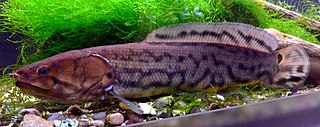
Amia, commonly called bowfin, is a genus of bony fish related to gars in the infraclass Holostei. They are regarded as taxonomic relicts, being the sole surviving species of the order Amiiformes, which dates from the Jurassic to the Eocene, persisting to the present. There are two living species in Amia, Amia calva and Amia ocellicauda, and a number of extinct species which have been described from the fossil record.

Sinamiidae is an extinct family of ray-finned fish. They are halecomorph fishes endemic to Early Cretaceous freshwater environments in East and Southeast Asia.

Parasemionotiformes is an extinct order of neopterygian ray-finned fish that existed globally during the Triassic period. It comprises the families Parasemionotidae and Promecosominidae. Many of the included genera are monotypic and most species lived during the Early Triassic epoch.

Redfieldiiformes is an extinct order of ray-finned fish (actinopterygians) which lived from the Middle Triassic to Early Jurassic. Redfieldiiforms were fairly typical Triassic fish in overall anatomy. They had a fusiform body shape with thick, ganoine-covered scales. The dorsal and anal fins were large, positioned opposite from each other, and shifted back, close to the tail. The caudal fin was hemiheterocercal, with the vertebral column and body scales extending into an upper lobe which was equal in size and shape to the lower lobe. They also had several characteristic skeletal traits, such as a hatchet-shaped preopercle, a series of fulcra fringing the fins, a reduced number of branchiostegal rays, and a snout ornamented with tubercles.

Lepidotidae is an extinct family of fish, known from the Jurassic and Cretaceous periods. Most species were originally assigned to the genus Lepidotes which was long considered a wastebasket taxon. Cladistic analysis has indicated that they are close relatives of gars, with both being members of the order Lepisosteiformes. Members of the family are known from both marine and freshwater environments. Their bulky body morphology and small median fins suggests that they were slow-moving fish that were capable of performing fine movements in order to grasp prey. Lepidotes sensu stricto had peg-like grasping marginal teeth and crushing palatal teeth, and is known to have consumed small crustaceans, while Scheenstia had low rounded crushing marginal teeth, indicating a durophagous diet.

Obaichthyidae is an extinct family of ginglymodian ray-finned fish that lived in what is now Africa and South America during the Cretaceous period. It was erected in 2010 by Lance Grande to include the genera Dentilepisosteus and Obaichthys. In 2012, it was defined as a stem-based taxon containing all taxa more closely related to Obaichthys than to the genera Lepisosteus, Pliodetes or Lepidotes.



